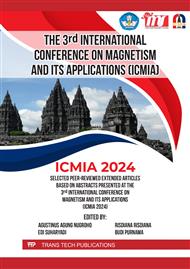[1]
Novoselov, K. S., Geim, A. K., Morozov, S. V., Dubunos S. V., Zhang, Y., and Jiang, D., Science 306, 5696 (2004).
Google Scholar
[2]
Takeda, K. and Shiraishi, K., Physical Review B 50, 20 (1994).
Google Scholar
[3]
Voon L. W., Zhu, J., and Schwingenschlögl, U., Applied Physics Reviews 3, 4 (2016).
Google Scholar
[4]
Chowdhury, S. and Jana, D., A theoretical review on electronic, Reports on Progress in Physics 79, 12 (2016).
Google Scholar
[5]
Nakano, H., Mitsuoka, T., Harada, M., Horibuchi, K., Nozaki, H., Takahashi, N., ... and Nakamura, H., Angewandte Chemie International Edition, 38 (2006).
DOI: 10.1002/ange.200600321
Google Scholar
[6]
Vogt, P., De Padova, P., Quaresima, C., Avila, J., Frantzeskakis, E., Asensio, M. C., ... and Le Lay, G., Physical review letters, 15 (2012).
DOI: 10.1103/physrevlett.108.155501
Google Scholar
[7]
Balendhran, S., Walia, S., Nili, H., Sriram, S., and Bhaskaran, M., small, 6 (2015).
Google Scholar
[8]
Ali, M., Pi, X., Liu, Y., and Yang, D., AIP Advances, 4 (2017).
Google Scholar
[9]
Xie, L., Zhu, Q., Zhang, G., Ye, K., Zou, C., Prezhdo, O. V., ... and Jiang, J., Journal of the American Chemical Society, 9 (2020).
Google Scholar
[10]
Neugebauer, J., and Van de Walle, C. G., Applied physics letters, 13 (1996).
Google Scholar
[11]
Cahangirov, S., Topsakal, M., Aktürk, E., Şahin, H., and Ciraci, S., Physical review letters, 23 (2009).
Google Scholar
[12]
Mortazavi, B., Rahaman, O., Makaremi, M., Dianat, A., Cuniberti, G., and Rabczuk, T., Physica E: Low-dimensional Systems and Nanostructures, 87 (2017).
DOI: 10.1016/j.physe.2016.10.047
Google Scholar
[13]
Ishii, F., and Saito, M., Japanese Journal of Applied Physics, 1 (2015).
Google Scholar
[14]
Śpiewak, P., Vanhellemont, J., and Kurzydłowski, K. J., Journal of Applied Physics, 6 (2011).
Google Scholar
[15]
Trivedi, S., Srivastava, A., and Kurchania, R., Journal of Computational and Theoretical Nanoscience, 3 (2014).
Google Scholar
[16]
Zheng, F. B., and Zhang, C. W., Nanoscale research letters, 7 (2012).
Google Scholar
[17]
PHASE0, http://www.ciss.iss.u-tokyo.ac.jp/dl/index.php
Google Scholar
[18]
Birch, F., Physical review, 71 (1947).
Google Scholar
[19]
Zhuravlev, K. K., Physica B: Condensed Matter, 394 (2007).
Google Scholar
[20]
Şahin, H., Cahangirov, S., Topsakal, M., Bekaroglu, E., Akturk, E., Senger, R. T., and Ciraci, S., Physical Review B, 80 (2009).
DOI: 10.1103/physrevb.80.155453
Google Scholar
[21]
Roome, N. J. and Carey, J. D., ACS applied materials & interfaces, 6 (2014).
Google Scholar
[22]
Priska, Z., Hidayati, S., Sholihun, S., Amalia, W., & Nurwantoro, P., Key Engineering Materials, 884 (2021).
DOI: 10.4028/www.scientific.net/kem.884.387
Google Scholar
[23]
Osborn, T. H., Farajian, A. A., Pupysheva, O. V., Aga, R. S., and Voon, L. L. Y, Chemical Physics Letters 511, 101-105 (2011).
DOI: 10.1016/j.cplett.2011.06.009
Google Scholar
[24]
Kumar, V., Santosh, R., Sinha, A., and Kumar, J., Journal of Molecular Modeling 27, 1-10 (2021).
Google Scholar
[25]
Kharadi, M. A., Malik, G. F. A., Khanday, F. A., Shah, K. A., Mittal, S., and Kaushik, B. K., ECS Journal of Solid State Science and Technology 9, 115031 (2020).
DOI: 10.1149/2162-8777/abd09a
Google Scholar
[26]
Venkatanarayanan, A., and Spain, E., Comprehensive Materials Processing, 13 (2014).
Google Scholar
[27]
Zhao, F., Feng, Y., and Feng, W., InfoMat 4, 12365 (2022).
Google Scholar
[28]
Griffiths, D. J., and Schroeter, D., Introduction to Quantum Mechanics, Pearson education, London, 2 (2005).
Google Scholar
[29]
Chowdhury, S., Bandyopadhyay, A., Dhar, N., and Jana, D., Physical Sciences Reviews, 2 (2017).
Google Scholar



